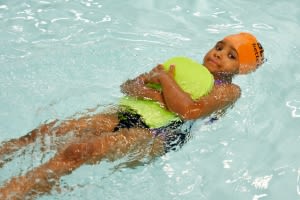Find a Swimming Pool Near You
Feel Great with Four Swimming Strokes
Learning these four swimming strokes comes after you have mastered the basic skills of swimming. Better have collated some tips to help you learn the four swimming strokes: front crawl, breaststroke, backstroke and butterfly.
Backstroke
Unsurprisingly, backstroke is an incredible workout for your back muscles, especially your upper back and is a great remedy for back aches and pains. If you've spent your day slouched at a desk, a few laps of the pool with this stroke will not only improve your posture by opening your upper chest and shoulder muscles, but will alleviate any tension and knots.
More so than the other strokes, it tightens your core due to the hip rotations, especially if you're an expert and practice your wall-kicks!
Fact: Backstroke is the only competitive swimming style which allows competitors to start in the pool, rather than diving in.
Breaststroke
Don't underestimate the humble breaststroke. Although it's the slowest competitive stroke, it has the potential to use up the most energy, so you will feel like you have had a solid workout! If you're hitting the water with this stroke, be sure to take a post-swim snack such as a banana.
It's a great stroke for recreational and new swimmers as you're able to keep your head out of the water. If you're a competitive or pro swimmer, it's likely you'll submerge your head with each stroke cycle and synchronise your breathing with your arm movements, which is fantastic for your overall lung functionality.
Fact: Captain Matthew Webb, the first man to swim the English Channel, swam 21.26 miles in breaststroke.
Butterfly
Often referred to as 'the fly', butterfly is considered the most challenging of the four strokes as it requires tight synchronisation and strong upper body muscles to propel you through the water. If you're looking to tone and define your abdominal, chest and upper arm muscles, then this is the perfect stroke for you.
Also, as the butterfly is split into three separate components; the pull, the push, and the recovery, with some practice and perseverance it has great results across the whole body.
Fact: Professional butterfly swimmers have always been advised to breathe every two strokes. Champion Michael Phelps, ditched this rule and breathes with every stroke.
Front Crawl / Freestyle
One of the oldest and arguably the easiest stroke to learn, the front crawl was first swam competitively in a race in London in 1844. To master this stroke, you'll need to practice making the length of your body streamlined, ensuring you achieve a slick glide through the water.
The distinctive 'flutter kick' is generated by some rigorous hip rotations and is perfect if you're looking to tone your glutes and hamstrings.
Fact: Front crawl is often used to refer to the competitive 'freestyle' as it's the fastest stroke, therefore the one most commonly chosen.

